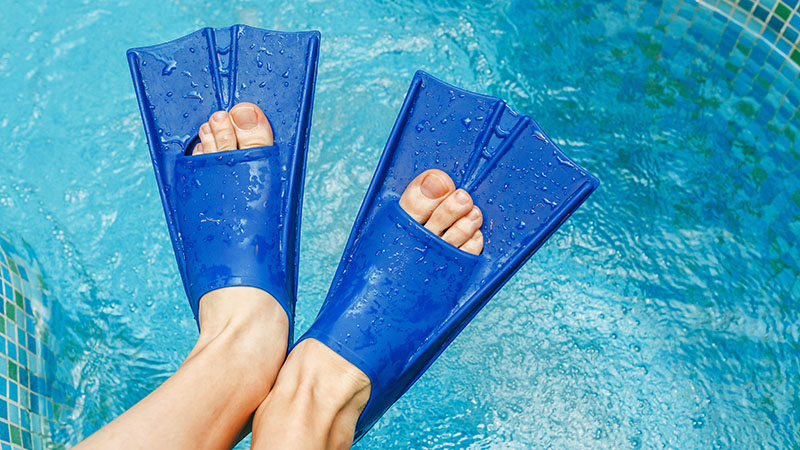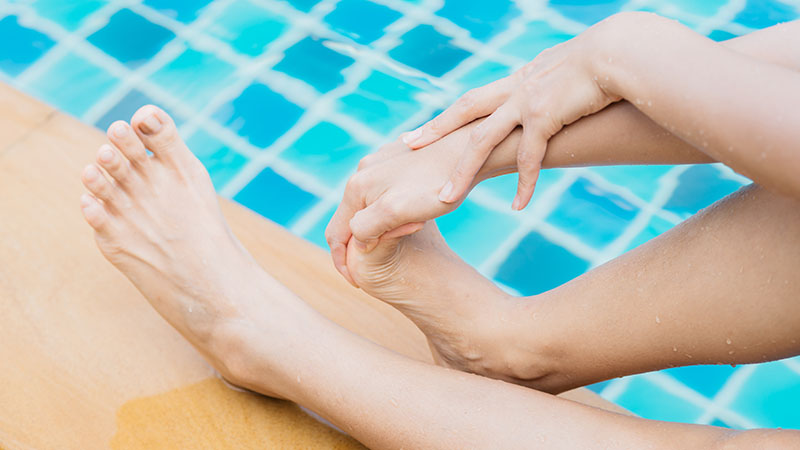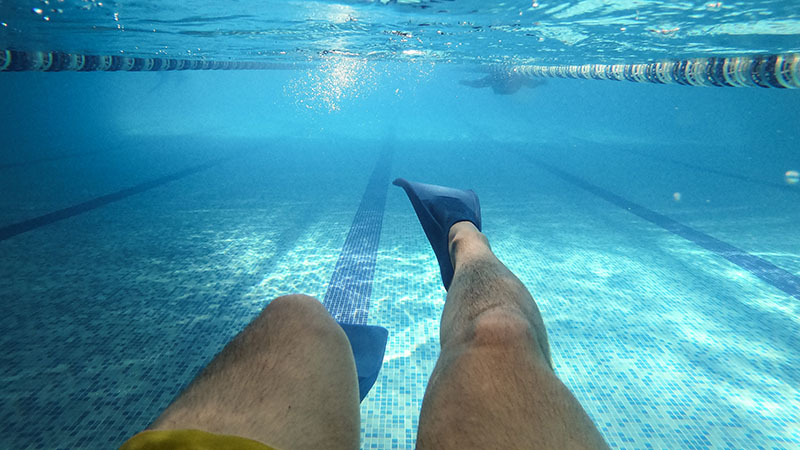Contents
How To Use Fins
When people picture someone swimming with fins, their minds typically think about someone in a wetsuit, getting ready to scuba dive or go snorkeling. They’re heading into the water from the beach or flipping into the water out of a boat. But, in reality, swimmers use fins in all sorts of ways and bring many benefits to swimming.
Fins are just one of the many tools used while swimming, like kickboards, that allow people to target different muscle groups or work on different aspects of their swimming techniques. Depending on the type of fins you get, your experience level, and what you want to get out of your training sessions, you will probably use them differently. But, before we dive into the specifics of which fins to choose and how to use them, let’s look at both the pros and cons of swimming with fins.
Benefits of Swimming With Fins

Reduces Strain on your Shoulders
Because fins allow you to cover more distance with less effort, they can reduce the strain and stress put on your shoulders. When you’re kicking with fins, you won’t have to work your upper body as hard. That means you can use fins during practice, when you’re swimming lots of laps, if you want a low-impact warm up, or if you are injured.
Increases Leg Strength
Conversely, from the point above, using fins will strengthen your legs. They allow you to put more emphasis on your lower body, meaning that it is putting in more work with more resistance, and you will probably see an improvement in your leg strength because of it.
Improved Body Position
Body positioning is important for swimming, and swimming with fins can help you with this. Fins allow you to keep your hips higher in the water, and this is important because a higher body line teaches the body to swim better and more quickly.
Increases Ankle Flexibility
Fins add resistance to your kicks. This resistance will train your ankles to change and become more flexible. While it may not sound important to have flexible ankles, it’s actually incredibly important if you ever want to increase your speed and agility in the water!
Helps Beginner Lap Swimmers
While fins add resistance to your kicks and they work on strengthening your leg muscles, they’re actually great for helping beginner lap swimmers! It helps them develop their kick technique, focus on improving their stroke techniques, build their resistance, and all the while allowing them to swim faster. All around fins are an excellent tool to use as a beginning lap swimmer, allowing them to focus on building their confidence and skills.
Fun to Use
Last, one of my favorite benefits of using fins while swimming is that they are just fun! Who wouldn’t want to swim faster if they had the choice? It will literally feel as if you are flying in the water if you’ve never used fins before!
Cons of Swimming With Fins

Develop Blisters
As I will discuss below with the different materials used when making fins, some may lend themselves to develop blisters if you’re not careful with your sizing. While they are great for swimming, the discomfort of developing blisters on your heels from the material rubbing against your skin is definitely something to monitor.
Develop Dependence
Yes, swimming with fins is a blast! You are going to swim faster, and you are going to feel accomplished and stronger when using them. However, you may become dependent on them in order to feel accomplished, as it can be pretty disappointing for some to swim without them if that’s all you’re used to.
Develop Joint Pain
Because fins add resistance and put more strain and effort on your ankles and knees, you would be more likely to develop some joint pain in those areas as opposed to swimming without fins. So, just keep this in mind if you have a history of joint pain in your knees or ankles, and monitor your use after discussing with your doctor!
How To Choose Swim Fins
Now that we’ve established the pros and cons of swimming with fins, you may look to invest in a pair for yourself. Before running to the store and selecting any old pair, it’s important to make sure that you pick the right type of fin for you. They come in many shapes, sizes, and styles, and it’s all important to consider before buying some for yourself.
Fin Length
The first thing to consider when buying fins for swimming is the length. Essentially, there’s long blade and short blade fins, and they each come with their own pros and cons. The longer blades are typically more flimsy and will create more resistance for you in the water. They are ideal for swimmers who aren’t wanting to use fins for speed, but want to use them for consistent and leisurely swims. Some regard them as better suited for young or newer swimmers. We prefer short blade fins for more advanced swimmers who are working on speed. Typically, these require more effort.
Fin Stiffness
More often than not, we can also correlate fin stiffness with the fin length. However, there are some instances where different materials can also affect whether the fin is stiff or soft. Fins that are more stiff require more work as they add more resistance, which will improve your leg strength and endurance. This may also mean that you will not swim as fast as you would with softer, more flexible fins.
Closed Heel vs Open Heel Fins
Another choice to consider when selecting a type of fin for swimming is whether you want an open heel or “full foot” (closed heel). A closed heel fin encases your entire foot in the rubber or material in which it is made, whereas an open heel simply has a plastic, adjustable strap. When considering which you prefer, a closed heel fin will be a perfect fit, but it can also lead to uncomfortable rubbing or blisters if it isn’t perfectly sized with your foot.
Silicone vs Rubber Fins
More often than not, they make fins out of silicone or rubber. While they both have their own pros and cons, more and more people are preferring silicone. They seem to prevent blisters and uncomfortable rubbing and last longer without warping and cracking. But, try on both rubber and silicone fins for yourself just to see what you prefer.
How to Use Fins in Your Swim Workout

Now that we’ve explored the pros and cons of swimming with fins along with tips for choosing the ones that are just right for you, let’s think about how to use fins. Foremost, here are some key tips for proper use…
- Focus on kicking with your entire leg, starting at your hips. Often, people new to fins will kick from their ankles, and this can cause potential straining.
- Remember to make small and quick kicks. Your legs should never really separate more than 12 inches when kicking, so focus on small, but powerful movements.
- Don’t kick out of the water. Yes, you should be up higher in the water, but you should keep your fins kicking in the water at all times. So, if you hear some big splashes coming from behind you, adjust your kicking.
Now that we’ve got some tips on how to use fins during your swim workouts, let’s talk about some different swim workouts that you can do with them.
Side Kick Drill
A sidekick drill is a great way to work on your kick while improving your alignment and body positioning. As the name suggests, you will kick on your side with the arm closest to the bottom of the pool shooting out straight in front of you and the arm closest to the top of the water in alignment with your legs. Your shoulder should be pointed up and out of the water. Keeping your core tight, kick your legs steadily, and practice breathing by looking up, taking breaths, and then looking back down into the water. It’s suggested that you alternate sides you are working on each time you reach the end of the pool or alternate each lap.
6/1/6 and 6/3/6 Drills
6/1/6 and 6/3/6 are both drills in which you can use your fins to strengthen your endurance and your legs. The numbers represent the pattern in terms of the number of kicks and strokes. For a 6/1/6 drill, you would do 6 kicks, 1 stroke, then another 6 kicks. 6/3/6 is the same except you are doing 3 strokes in between your kicks. These types of drills allow you to focus on your kicking in your fins, like a sidekick drill, but with more of a pattern.
Practicing Butterfly Kick
For the butterfly stroke, swimmers use a kick called the dolphin kick. This kick is where you keep your legs together and comprises a downbeat and an upbeat. The downbeat is where the legs are propelled by pushing downward, whereas the upbeat is when the legs move upward to prepare for the next propulsion. Working on this kick with fins is a great way to get a good workout and strengthen both your form and your legs.
Speed Workouts
The last example of how to use fins for a workout is probably the most self explanatory. As I’ve mentioned previously, fins allow swimmers to swim with more speed. So, why not work on your speed with some high-intensity interval training swim workouts while you’re wearing your fins?
